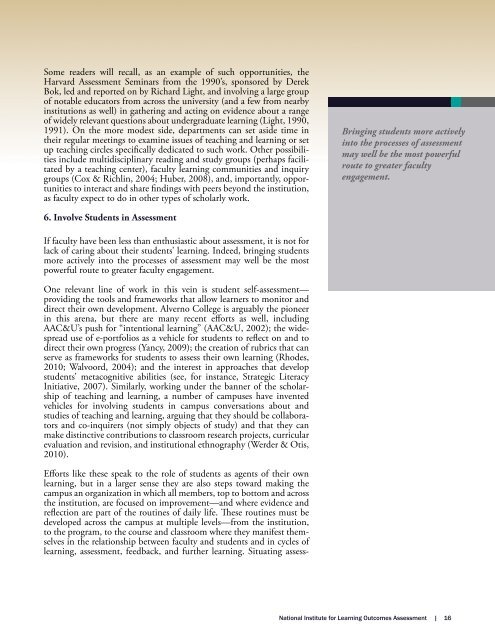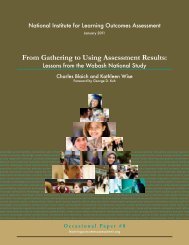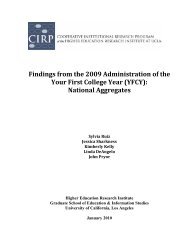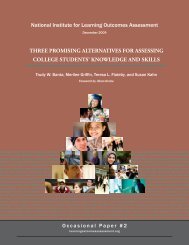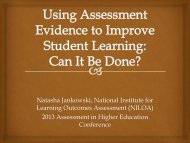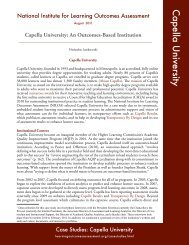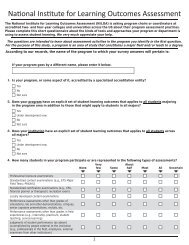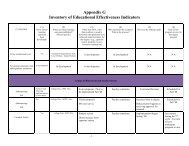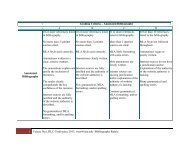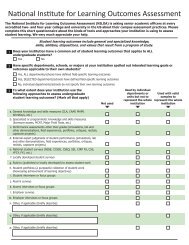Opening Doors to Faculty Involvement in Assessment - National ...
Opening Doors to Faculty Involvement in Assessment - National ...
Opening Doors to Faculty Involvement in Assessment - National ...
Create successful ePaper yourself
Turn your PDF publications into a flip-book with our unique Google optimized e-Paper software.
Some readers will recall, as an example of such opportunities, the<br />
Harvard <strong>Assessment</strong> Sem<strong>in</strong>ars from the 1990’s, sponsored by Derek<br />
Bok, led and reported on by Richard Light, and <strong>in</strong>volv<strong>in</strong>g a large group<br />
of notable educa<strong>to</strong>rs from across the university (and a few from nearby<br />
<strong>in</strong>stitutions as well) <strong>in</strong> gather<strong>in</strong>g and act<strong>in</strong>g on evidence about a range<br />
of widely relevant questions about undergraduate learn<strong>in</strong>g (Light, 1990,<br />
1991). On the more modest side, departments can set aside time <strong>in</strong><br />
their regular meet<strong>in</strong>gs <strong>to</strong> exam<strong>in</strong>e issues of teach<strong>in</strong>g and learn<strong>in</strong>g or set<br />
up teach<strong>in</strong>g circles specifically dedicated <strong>to</strong> such work. Other possibilities<br />
<strong>in</strong>clude multidiscipl<strong>in</strong>ary read<strong>in</strong>g and study groups (perhaps facilitated<br />
by a teach<strong>in</strong>g center), faculty learn<strong>in</strong>g communities and <strong>in</strong>quiry<br />
groups (Cox & Richl<strong>in</strong>, 2004; Huber, 2008), and, importantly, opportunities<br />
<strong>to</strong> <strong>in</strong>teract and share f<strong>in</strong>d<strong>in</strong>gs with peers beyond the <strong>in</strong>stitution,<br />
as faculty expect <strong>to</strong> do <strong>in</strong> other types of scholarly work.<br />
Br<strong>in</strong>g<strong>in</strong>g students more actively<br />
<strong>in</strong><strong>to</strong> the processes of assessment<br />
may well be the most powerful<br />
route <strong>to</strong> greater faculty<br />
engagement.<br />
6. Involve Students <strong>in</strong> <strong>Assessment</strong><br />
If faculty have been less than enthusiastic about assessment, it is not for<br />
lack of car<strong>in</strong>g about their students’ learn<strong>in</strong>g. Indeed, br<strong>in</strong>g<strong>in</strong>g students<br />
more actively <strong>in</strong><strong>to</strong> the processes of assessment may well be the most<br />
powerful route <strong>to</strong> greater faculty engagement.<br />
One relevant l<strong>in</strong>e of work <strong>in</strong> this ve<strong>in</strong> is student self-assessment—<br />
provid<strong>in</strong>g the <strong>to</strong>ols and frameworks that allow learners <strong>to</strong> moni<strong>to</strong>r and<br />
direct their own development. Alverno College is arguably the pioneer<br />
<strong>in</strong> this arena, but there are many recent efforts as well, <strong>in</strong>clud<strong>in</strong>g<br />
AAC&U’s push for “<strong>in</strong>tentional learn<strong>in</strong>g” (AAC&U, 2002); the widespread<br />
use of e-portfolios as a vehicle for students <strong>to</strong> reflect on and <strong>to</strong><br />
direct their own progress (Yancy, 2009); the creation of rubrics that can<br />
serve as frameworks for students <strong>to</strong> assess their own learn<strong>in</strong>g (Rhodes,<br />
2010; Walvoord, 2004); and the <strong>in</strong>terest <strong>in</strong> approaches that develop<br />
students’ metacognitive abilities (see, for <strong>in</strong>stance, Strategic Literacy<br />
Initiative, 2007). Similarly, work<strong>in</strong>g under the banner of the scholarship<br />
of teach<strong>in</strong>g and learn<strong>in</strong>g, a number of campuses have <strong>in</strong>vented<br />
vehicles for <strong>in</strong>volv<strong>in</strong>g students <strong>in</strong> campus conversations about and<br />
studies of teach<strong>in</strong>g and learn<strong>in</strong>g, argu<strong>in</strong>g that they should be collabora<strong>to</strong>rs<br />
and co-<strong>in</strong>quirers (not simply objects of study) and that they can<br />
make dist<strong>in</strong>ctive contributions <strong>to</strong> classroom research projects, curricular<br />
evaluation and revision, and <strong>in</strong>stitutional ethnography (Werder & Otis,<br />
2010).<br />
Efforts like these speak <strong>to</strong> the role of students as agents of their own<br />
learn<strong>in</strong>g, but <strong>in</strong> a larger sense they are also steps <strong>to</strong>ward mak<strong>in</strong>g the<br />
campus an organization <strong>in</strong> which all members, <strong>to</strong>p <strong>to</strong> bot<strong>to</strong>m and across<br />
the <strong>in</strong>stitution, are focused on improvement—and where evidence and<br />
reflection are part of the rout<strong>in</strong>es of daily life. These rout<strong>in</strong>es must be<br />
developed across the campus at multiple levels—from the <strong>in</strong>stitution,<br />
<strong>to</strong> the program, <strong>to</strong> the course and classroom where they manifest themselves<br />
<strong>in</strong> the relationship between faculty and students and <strong>in</strong> cycles of<br />
learn<strong>in</strong>g, assessment, feedback, and further learn<strong>in</strong>g. Situat<strong>in</strong>g assess-


